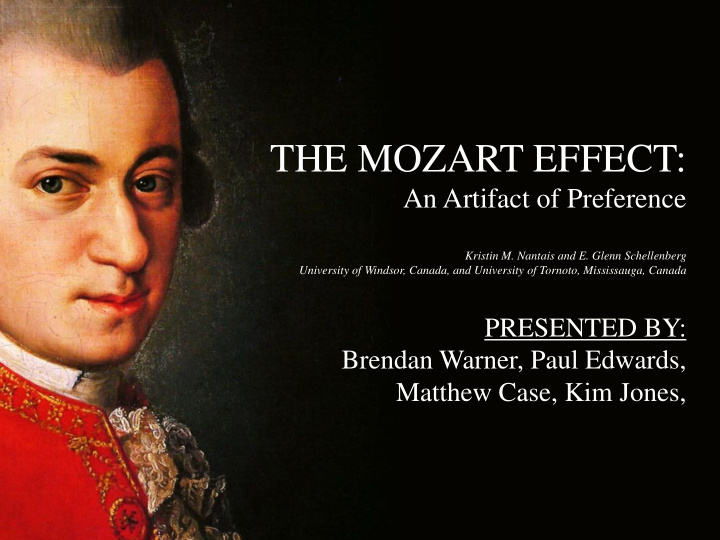



THE MOZART EFFECT: An Artifact of Preference Kristin M. Nantais and E. Glenn Schellenberg University of Windsor, Canada, and University of Tornoto, Mississauga, Canada PRESENTED BY: Brendan Warner, Paul Edwards, Matthew Case, Kim Jones,
Introduction The “Mozart Effect” Spatial-temporal abilities are enhanced after listening to music composed by Mozart Listening to Mozart makes you smarter Spatial-Temporal Being able to mentally rotate 2D and 3D objects
Introduction The “Mozart Effect” Similar to transfer or priming Key difference being that Mozart is listened to passively Cross-modal priming effects are weak
Introduction Reason Long term improvements have been shown as a consequence of music lessons. ○ What about the short term? Why Effect could improve performance of pilots or spatial engineers If proven can argue against independence of function across domains
Introduction Problems? Past research has been tough to replicate Media generalized that Mozart makes you smarter Difficult to situate the Mozart effect in known cognitive phenomena
Paper Folding and Cutting Task
Method Experiment 1 – 56 undergraduates Individually tested twice in a two-week period ○ Once for control (silence), once for stimulus One visit sat in silence for 10 minutes One visit listened to 10 minutes of either Mozart or Shubert During both visits, after the 10 minute period participants used a computer and mouse to complete a series of 17 PF&C tests.
Method Experiment 2 – 28 undergraduates Individually tested twice in a two-week period ○ Once for control (short story) once for stimulus One visit listened to 10 minutes of the short story “The Last Rung on the Ladder” One visit listened to 10 minutes of either Mozart or Shubert During both visits, after the 10 minute period participants used a computer and mouse to complete a series of 17 PF&C tests.
Results: Experiment 1 An ANOVA was used to examine performance as a function of condition, musical piece, and testing order. A main effect of condition revealed that scores on the spatial-temporal task were higher after listening to music than after sitting in silence (which accounted for 20% of the within-subjects variance)
Results: Experiment 1 The testing order indicated that performance improved from the first to the second session ( which accounted for 8% of the within-subject variance). No other main effects or interactions were significant.
Results: Experiment 2 An ANOVA that examined effects of condition and testing order revealed that performance improved from the first to the second testing session (accounting for 14% of the within- subjects variance). The main effect of condition was not significant and did not interact with testing order. In other words, the Mozart effect disappeared when the control condition consisted of a story rather than silence.
Results: Experiment 2 An ANOVA with three factors (condition, testing order, and preference) confirmed that preference interacted with condition. Overall levels of performance were better in participants’ preferred condition than in their non preferred condition. Participants who preferred the Mozart piece scored marginally higher than other participants across conditions.
Discussion “Mozart Effect” is a misnomer Same results achieved listening to short story and classical composers ○ No observable difference between musical stimulation and other positive mental stimulation
Discussion Better results could be explained by heightened mood and arousal, worse could be explained by lowered mood/arousal. ○ Low mood participants could be bored. Music facilitates emotional change.
Recommend
More recommend